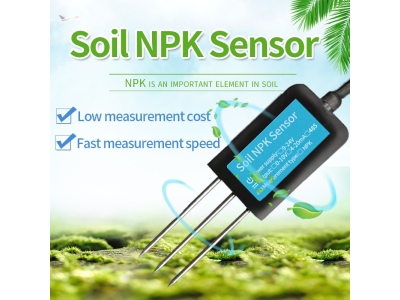Soil sensors are becoming increasingly popular in agriculture, environmental research, and landscaping to monitor soil conditions. These sensors provide valuable data on parameters such as moisture content, temperature, salinity, and nutrient levels, which are essential for making informed decisions about irrigation, fertilization, and plant health. In this article, we will discuss different application schemes of soil sensors in various fields.

Precision Agriculture:
Precision agriculture is a farming management concept that uses technology to optimize crop production and reduce waste. Soil sensors play a critical role in precision agriculture by providing real-time data on soil moisture, temperature, and nutrient levels. This information allows farmers to adjust irrigation, fertilization, and pesticide application rates based on the specific needs of each crop. Soil sensors can be used in precision agriculture in various ways:
a. Variable Rate Irrigation (VRI): VRI is a technique that adjusts the amount of water applied to each crop based on its individual needs. Soil sensors are used to measure soil moisture levels and determine how much water is necessary for each area of the field. VRI systems use this data to control the flow rate of water to each crop, ensuring optimal water usage.
b. Site-Specific Nutrient Management (SSNM): SSNM is a fertilization technique that optimizes nutrient application rates based on the specific needs of each crop. Soil sensors are used to measure soil nutrient levels, allowing farmers to adjust their fertilizer application rates accordingly. SSNM helps reduce fertilizer waste and prevent soil degradation caused by excess nutrients.
c. Crop Health Monitoring: Soil sensors can also be used to monitor the health of crops. By measuring soil moisture levels, temperature, and nutrient levels, farmers can identify early signs of stress or disease and take corrective actions before significant crop damage occurs.
Environmental Research:
Soil sensors are also used in environmental research to monitor soil conditions and assess the impact of land use changes on soil properties. Soil sensors can provide valuable information on soil moisture, temperature, and nutrient levels, which are essential for understanding soil health and ecosystem functions. Some application schemes of soil sensors in environmental research include:
a. Soil Moisture Monitoring: Soil moisture is a critical factor that affects soil health, plant growth, and ecosystem functions. Soil sensors can be used to measure soil moisture levels at different depths, allowing researchers to understand how water moves through the soil and how it affects plant and microbial communities.
b. Carbon Sequestration Monitoring: Soil carbon sequestration is an essential process that helps mitigate climate change by removing carbon dioxide from the atmosphere and storing it in the soil. Soil sensors can be used to monitor soil organic matter content and assess the effectiveness of land use management practices in promoting carbon sequestration.
c. Erosion Monitoring: Soil erosion is a significant environmental problem that affects soil productivity and water quality. Soil sensors can be used to measure soil moisture levels and assess the risk of soil erosion. By identifying areas with high erosion risk, researchers can develop effective erosion control strategies.
Landscaping:
Soil sensors can also be used in landscaping to monitor soil conditions and optimize plant health. By providing real-time data on soil moisture, temperature, and nutrient levels, soil sensors can help ensure that plants receive the optimal amount of water and nutrients. Some application schemes of soil sensors in landscaping include:
a. Irrigation Management: Soil sensors can be used to monitor soil moisture levels and adjust irrigation schedules accordingly. This helps prevent overwatering or underwatering, which can lead to plant stress or disease.
b. Plant Nutrient Management: Soil sensors can also be used to monitor soil nutrient levels and adjust fertilizer application rates based on the specific needs of each plant. This helps promote healthy plant growth and reduces fertilizer waste.
c. Soil Health Monitoring: Soil sensors can be used to monitor soil temperature and moisture levels, allowing landscapers to identify areas with poor soil health. By taking corrective measures such as soil amendment or aeration, landscapers can improve soil health and promote healthy plant growth.
Conclusion:
Soil sensors are versatile devices that have numerous applications in agriculture, environmental research, and landscaping. By providing real-time data on soil moisture, temperature, salinity, and nutrient levels, soil sensors can help optimize crop production, mitigate environmental problems, and promote healthy plant growth. As technology continues to advance, soil sensors will become increasingly sophisticated and valuable tools for land management practices.





